A few months ago, my girlfriend and I sat down to watch the best movie ever made about the Titanic – and no, I’m not referring to the one rereleased this past weekend in 3D…
I think the world is divided into two camps: those who love James Cameron’s Hollywood epic, and those who never want to hear the word Titanic again because of it.
Regardless of where you fall, watch A Night To Remember, and I guarantee you’ll suddenly remember why the Titanic once held a sense of fascination for you.
Gone is the unnecessary love story, the endless cliches, the one-dimensional characters, the terrible acting; in its place is simply the true story of what actually occurred, moment by chilling moment (to this day, it’s considered the most accurate historical depiction of the tragedy).
As I was watching, I became curious: the Titanic’s intended destination was New York. What still remained in the city with a connection to the ill-fated voyage? Here’s what I could come up with – Part 2 to follow on Wednesday.
Below is a map to give you a quick overview of where we’re headed:
View The Titanic Guide To New York City, from Scouting NY in a larger map
The best place to start our tour is at the remnants of Pier 54, just south of 14th Street at the West Side Highway.
The Titanic was actually due at the White Star’s Pier 59, located just north at about 18th Street. Below, a photograph of the White Star piers taken in 1905:
Today, all of that is long gone, replaced by the sprawling Chelsea Piers sports complex:
However, one of the coolest remnants from the White Star’s former piers are the hundreds of dock posts still poking out of the harbor:
After rescuing the survivors, the RMS Carpathia, a Cunard ship, first stopped at the White Star’s Pier 59 to unload the Titanic’s lifeboats, then moored at Cunard’s Pier 54 for the passengers to disembark.
If you look closely at the central beam, you can still see overlapping lettering identifying it as both a Cunard and White Star pier (the companies merged in 1934):
Pictured below is the Carpathia, docked on the north side of Pier 54 just after its rescue mission to the Titanic:
The pier’s shed in the background suffered a fire in 1932 and was replaced by a second building, seen below, which was demolished in 1991.
Today, the length of the pier is used an outdoor event space:
Our next stop is the former “American Seamen’s Friend Society Sailors’ Home and Institute,” just a few blocks south on Jane Street, where surviving members of the Titanic’s crew were given free housing and food after landing in New York:
Founded in 1828, The Seamen’s Friend Society was a Christian organization offering room and board to sailors in an attempt to get them away from New York’s “dives, dancehalls, saloons” and other establishments of ill repute.
Designed by William A. Boring (also responsible for Ellis Island), the building featured a number of nautical motifs, including a lighthouse-like turret (seen above in a 1927 photograph) which flashed a beacon over the Hudson. Sadly, this was removed when the YMCA purchased the building in 1944.
However, a number of nautical bits still remain today…
…like the pair of roped anchors over the door…
…and two fish holding life preservers on the western facade:
The original 156 rooms at the Seamen’s Friend Society were designed to mimic a ship’s cabin rooms in both size and design, a tradition that The Jane Hotel has continued today (which is why rates are relatively cheap!):

The day after the survivors arrived in New York City, a memorial service was conducted here, with 125 crew members in attendance.
The Jane Hotel did a tremendous renovation of the lobby in 2008 (at the time, the hotel was basically a flop house), but there is one Titanic remnant that managed to survive. As you enter, a fountain on the left dates to the original Seamen’s Friend Society…
Beneath it is a gold plaque, which was once a memorial to the Titanic. Completely worn by age, there literally isn’t a single letter left.
We’ll now head south to 9/11 Broadway, the former New York headquarters of Titanic’s White Star Line (rival Cunard is located directly next door at #25).
In the days following the Titanic’s sinking, thousands gathered outside for word of survivors, as wireless communications were sent directly to the White Star’s offices from steamships on site.
The entrance to the White Star offices was this central door, which today leads to a Subway and a RadioShack.
Below, the entrance in its pre-$5-Foot-Long glory days, surrounded by crowds waiting for news of the Titanic:
Our next stop is just around the corner at the wonderfully petite “Shrine of St. Elizabeth Ann Seton at Our Lady of the Rosary Parish,” located at 7 State Street. In 1912, it was simply the Our Lady of the Rosary Mission, and many women from steerage class were given temporary lodging here.

Normally, we’d head across the street to Battery Park to see the Wireless Operators Memorial, commemorating wireless operators lost at sea. However, IT IS NOT THERE! Despite just about every recent Titanic walking tour article mentioning it as a necessary stop, it was removed years ago for the on-going renovations to the park, and has yet to be returned.
However, stop by when it is restored, and you’ll find the name Jack Phillips listed with the S.S. Titanic.
Phillips was the Titanic’s senior wireless operator, and turned 25 a day before the journey. Though several messages warning of ice were received from nearby ships, Phillips had been told by Captain Edward J. Smith to ignore them.
After the Titanic collided with an iceberg and began sinking, Phillips worked tirelessly to send distress calls until the wireless room power was nearly dead. He was able to make it to an overturned lifeboat and survive the night clinging to its side, but ultimately died the following morning. The rowboat was later recovered, pictured below:

Incredibly, wireless operators lost at sea are listed on the memorial right up through 1994, with the sinking of the S. S. Salvadore Allende:
From Battery Park, follow Water Street north-east to the South Street Seaport and you’ll come across New York’s primary Titanic Memorial at its entrance:
Don’t feel bad if you didn’t realize this had anything to do with the Titanic – I passed it for years assuming it was just one of the many nautical flourishes added by the South Street Seaport Museum (complete, apparently, with what appeared to be its own miniature New Year’s Eve ball).
However, this lighthouse-esque monument is actually a memorial to the Titanic, paid for for by public donations in 1913.
Originally placed atop the Seamen’s Church Institute of New York & New Jersey at 25 South Street, it was equipped with a green light which could be seen from as far as Sandy Hook, NJ.
Perched above the lighthouse was a time ball, which lowered every day at exact noon to mark the time for navigators.
The time ball was restored to working order for a rededication in 1986, though I’m not sure if it still functions today. A clock and other mechanical devices can still be seen through its windows.
Often blocked by the hot dog vendor that set up shop in front of the monument, this is the memorial plaque mounted on its side:
The Seamen’s Church Institute, founded in 1838 to offer aid to sailors and mariners, still exists to this day, though in 1968, it moved to new headquarters and its 25 South Street location was demolished. The Titanic Memorial was donated to the Friends of the South Street Seaport group, and installed in its current location in 1976. Today, this…
…looks like this:
The Seamen’s Church Institute actually had quite a presence in the area once. In fact, as you make your way north to our next stop, take a moment to pause under the Manhattan Bridge at Pike Street for a quick diversion.
The Institute was particularly famous for its “floating churches,” and if you were able to travel back in time about a hundred years, you’d find The Floating Church of our Savior (1870-1910) bobbing in the water here!
Seriously, how crazy is that?
Inside the church in 1899 at Christmas, with decorations in place. This particular church burned down in 1910:
The Seamen’s Church Institute had floating churches in the harbor from 1849 through 1958, when its final location was destroyed in a fire. Below, the 1849 church, which I really, really wish was still floating around the harbor:
Speaking of churches, our next stop is Grace Church, at West 10th Street and Broadway:
As you head inside, turn to the left…
…and just below the stained glass window, you’ll see a memorial to Edith Corse Evans, “who in the midst of life gave herself for others on the Titanic.”
Edith Corse Evans was one of only four First Class women who died on the Titanic (according to legend, Evans had recently consulted a fortune teller in London, who warned her to “beware of the water”). Having missed the first round of lifeboats, Evans began searching for another with a passenger named Caroline Brown. A boat with one seat available was discovered, and Evans urged Brown to board, as she had children waiting for her at home.
This lifeboat was the last to be lowered from the Titanic. Evans’s body was never found; a memorial service was performed at Grace Church on April 22, 1912.
CLICK HERE TO CONTINUE TO PART 2!
-SCOUT
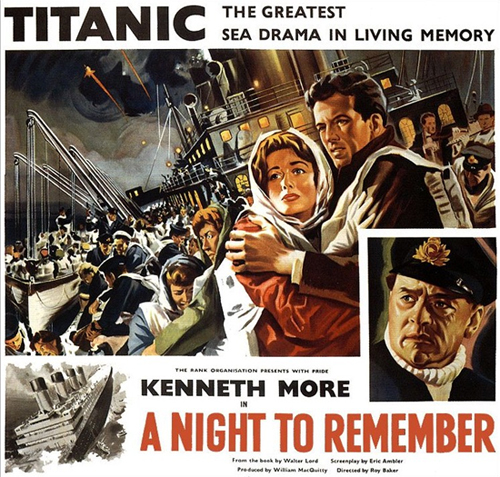

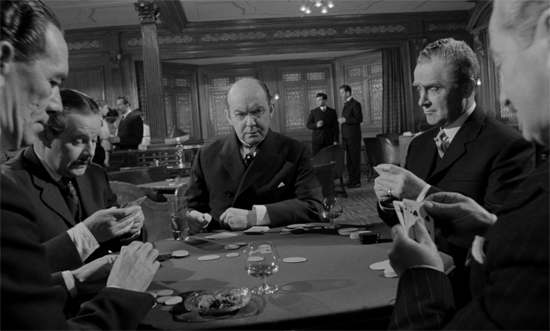



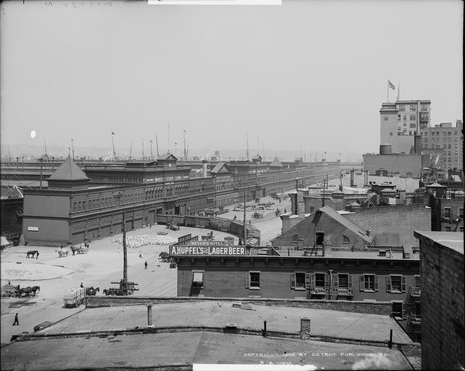
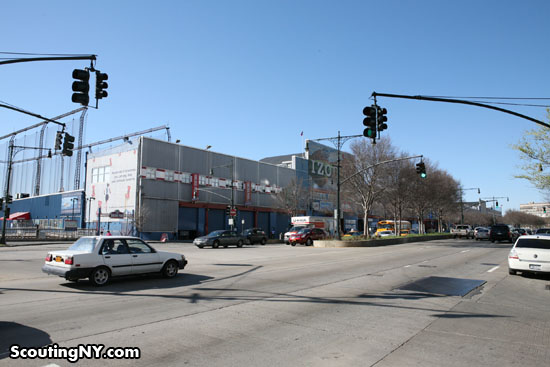






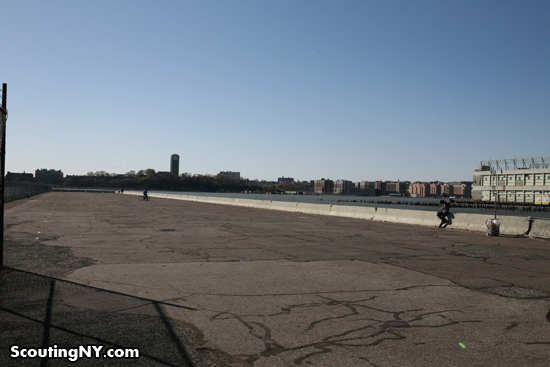
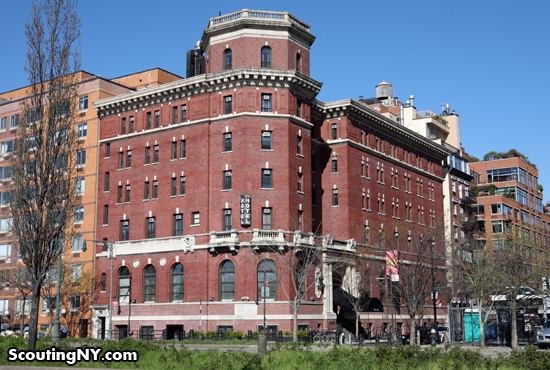

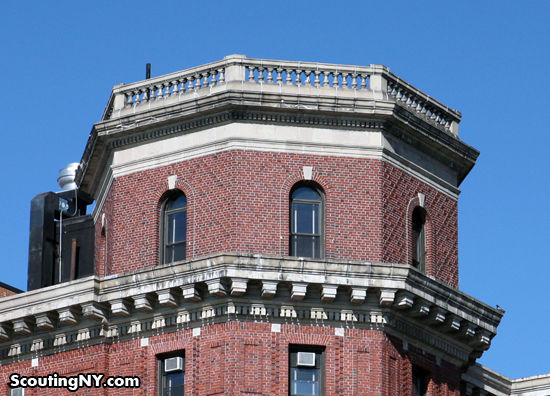

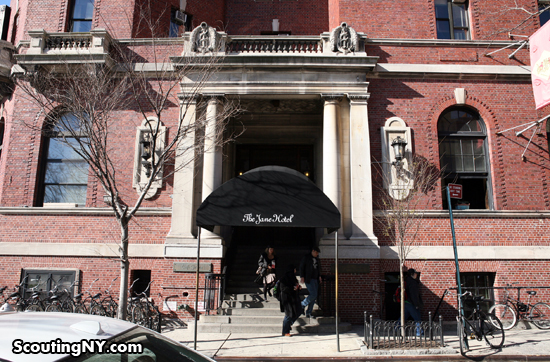

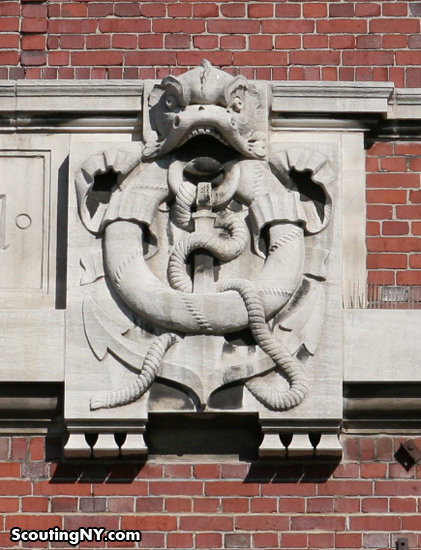
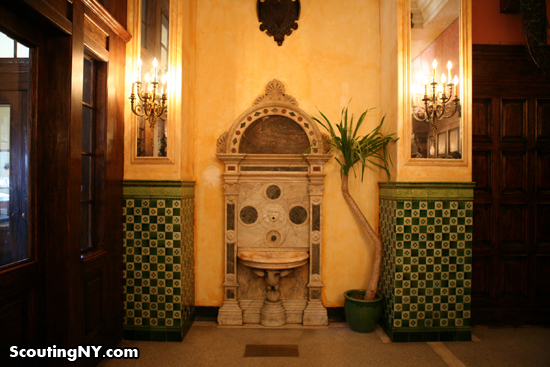

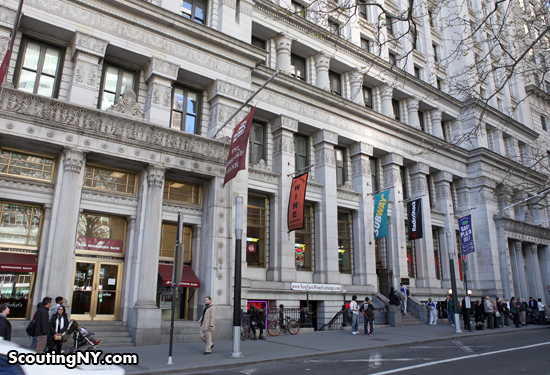
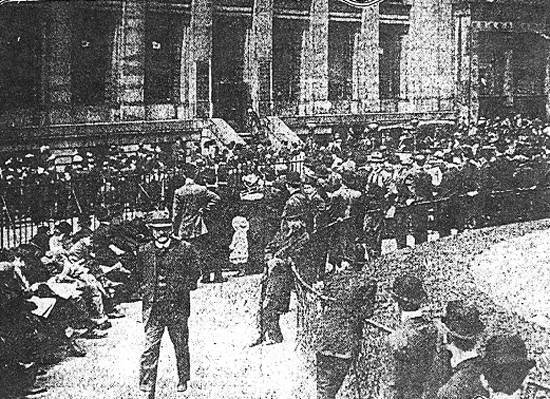

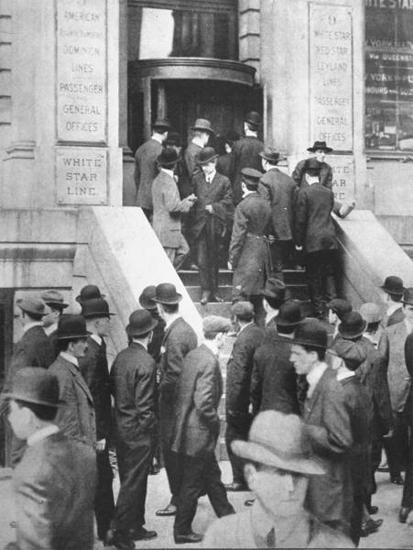



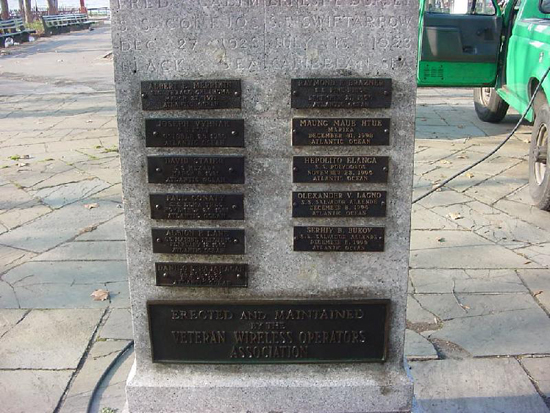
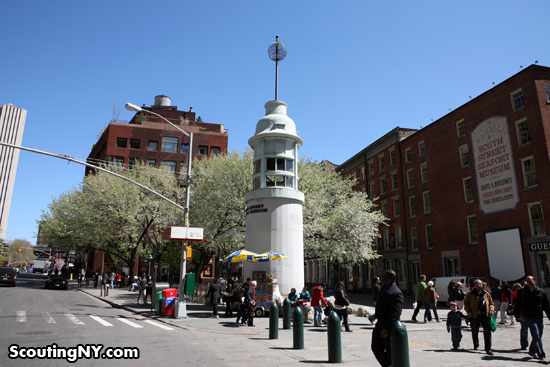
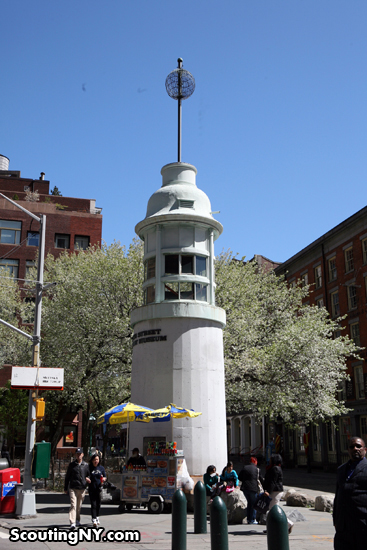

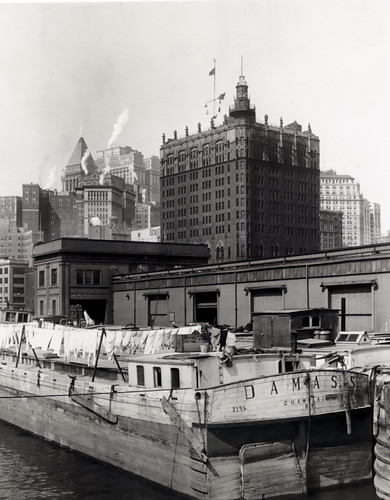

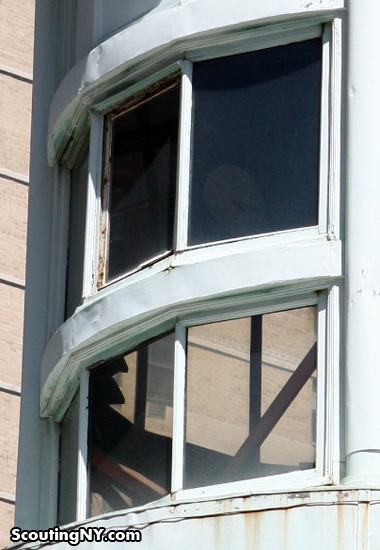
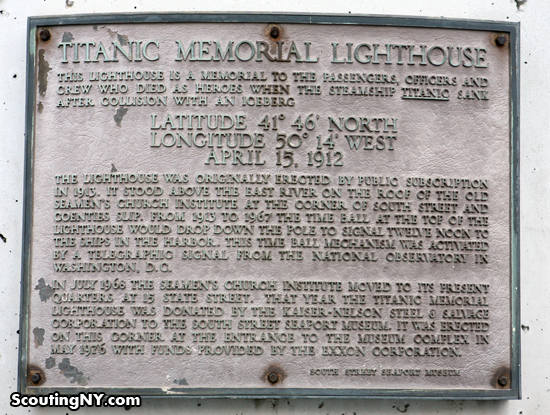
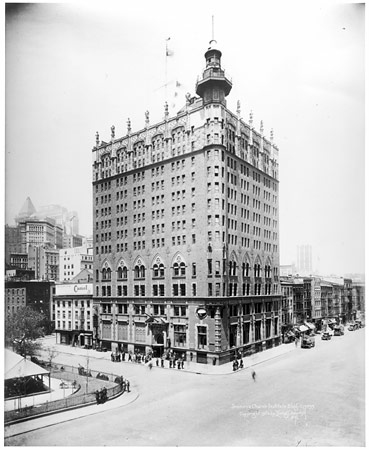

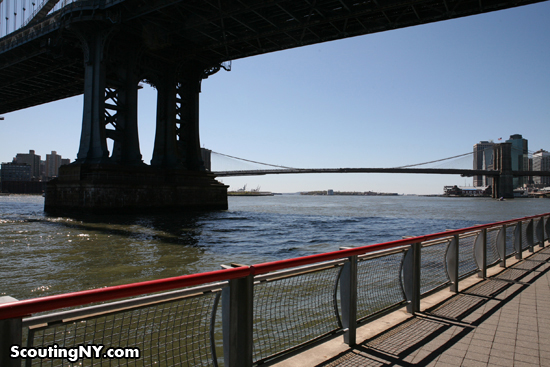


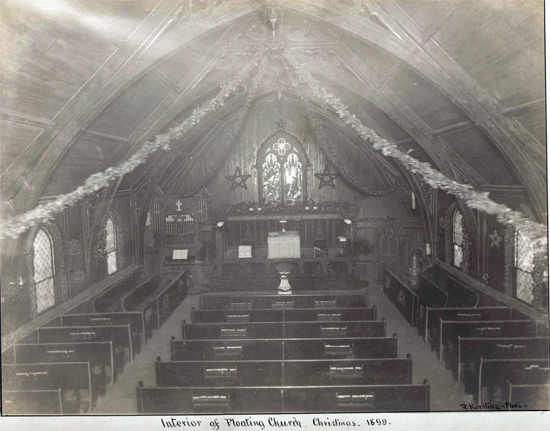
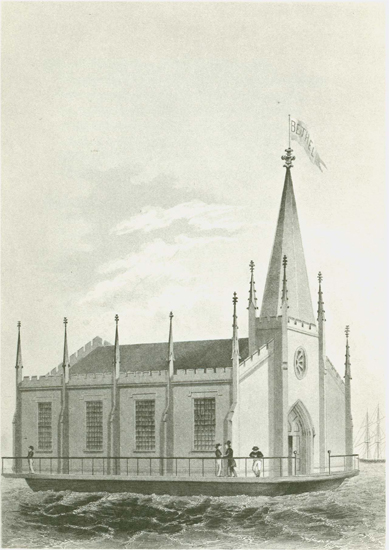
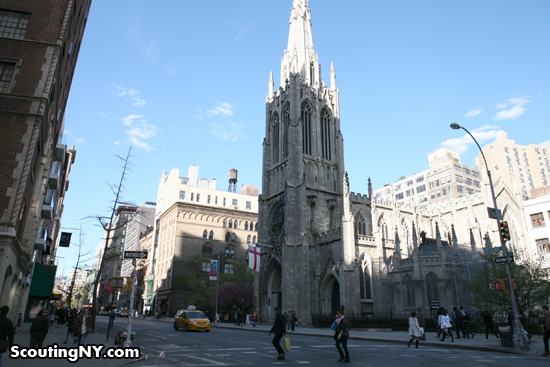
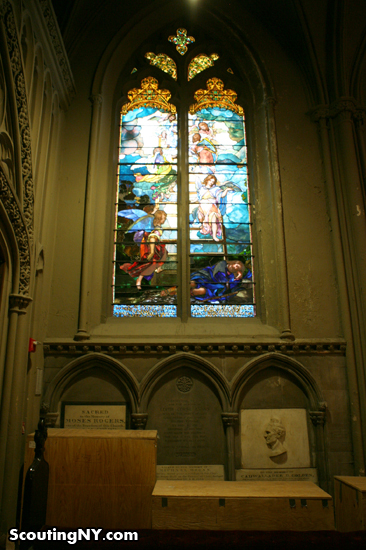
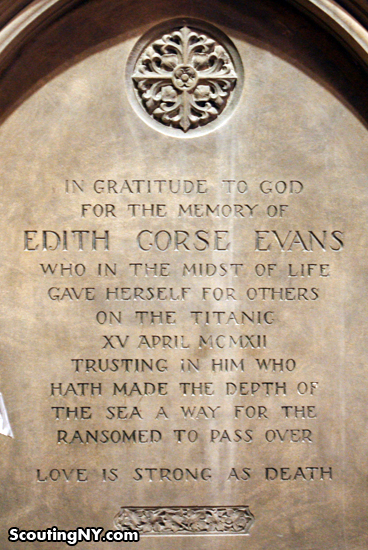
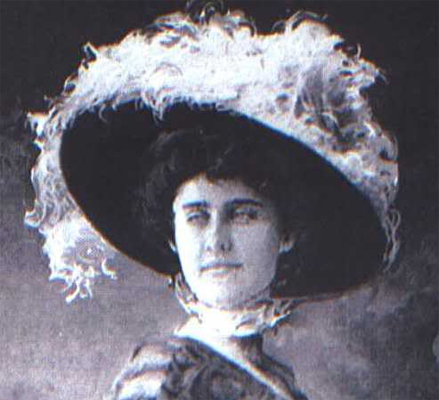

great article
Fantastic article, keep up the great work!
Another great article, shared on my FB wall.
thank you. I was in the “Jane Hotel” when it was a flophouse.
Amazing detail and unusual facts.
We are fortunate to have someone with your keen sense of history and detail who also handles a camera expertly. You have given us many memorable NY tours—this one is in the top tier. Thank you.
And I totally agree with your assessments of the two Titanic films—”A Night to Remember” is, indeed, the film to remember.
I was hoping you were going to do something like this.
Thank you for the research that you put into this one. Do you know whether the “floating churches” actually sailed much, or did they usually remain docked?
I stayed at the Jane Hotel two years ago. For only $60 I got one of those little twin bed rooms, and though it was the size of my closet, it was an incredibly fun experience to be all cozy in there. Plus there’s crazy amenities (a plasma mounted over the bed, an iPod dock, etc). They also have old-fashioned fans mounted over the bed, and if you get a room facing the river, you can open the window for an excellent breeze. The only weird part is that many of the rooms are still lived in by the former flop-house renters (who pay something ridiculous like $50/month). The management is hoping they’ll all leave/die soon, but until then you’ll end up sharing the fabulous, retro-remodeled hall baths with some real live New Yorkers (and I’m not talking the Carrie Bradshaw variety).
Lauren,
you’re a pathetic reminder of the apathy your generation represents.
here’s to hoping ppl like you die soon, too!!
“A night to remember” is still the best book on the Titanic as well, and “The Night Lives On,” his mid 80’s follow up after the discovery is pretty good too.
A Night to Remember and Day of Infamy made me a Walter Lord fan.
In the 4th picture down of the New York American building, is that a person writing the latest news on a chalkboard?
Thanks, as always, for this trip through memories, Nick. Total agreement with which was the best movie about the Titanic!
I worked at 11 Broadway for many years, and never knew the White Star Line connection. Seeing that photo of Titanic-curious crowds gathered outside of a building I once entered every day gave me chills. Thanks!
http://en.wikipedia.org/wiki/Straus_Park
not sure if this is to be included in Part 2 as the journey heads further uptown??
Yup! Check back Wednesday…
I was waiting for Straus Park, too! It’s so lovely and sad.
Great piece, Scout. And, yes, “A Night to Remember” is far and away the most moving film on the Titanic ever.
Great collection of Titanic sites! I used to work at 17 State Street, next to the Elizabeth Ann Seton shrine and was familiar with the Cunard and White Star buildings and pier but was unaware of the other locations you unearthed. Those floating churches are so cool! I actually liked the recent film but mainly because of the attention to detail that was paid to the art and costume direction. I find no need to see it in 3D. I’m looking forward to your next entry.
One more Titanic site is uptown… The Isidor and Ida Straus Memorial is located in Straus Park, at the intersection of Broadway and West End Avenue at W. 106th Street (Duke Ellington Boulevard) in Manhattan.[5] The park is one block from 105th St. and West End Avenue, where they resided (now the site of the Cleburne Building). An inscription reads, “Lovely and pleasant they were in their lives, and in death they were not divided.” (2 Samuel 1:23)
Traveling from Germany back to the United States, Isidor and his wife were passengers on the RMS Titanic when, on April 14, 1912, it hit an iceberg. Their baby grandson, Stuart Scheftel, had caught a cold and been left behind in England with his nurse, or else he would have been on the ship with them. Ida reportedly would not leave Isidor and refused to get in a lifeboat. The officer filling up the boat told Isidor that he could get into the boat with his wife, but he refused to before younger men but instead sent his wife’s maid, Ellen Bird, into the boat. Ida refused to board the half-full boat, saying “I will not be separated from my husband. As we have lived, so will we die, together.”[4] Isidor and Ida were last seen on deck sitting in deck chairs holding hands when a huge wave washed them into the sea. Both died on April 15 when the ship sank. Isidor Straus’s body was recovered by the cable ship Mackay-Bennett and brought to Halifax, Nova Scotia where it was identified before being shipped to New York. He was buried in Woodlawn Cemetery in the Bronx. Ida’s body was not recovered.[5] (Baby Stuart grew up to marry actress Geraldine Fitzgerald.)[6]
The couple are portrayed in the 1953 film Titanic and the 1958 film A Night to Remember, in scenes that are faithful to the accounts just cited. In the 1997 film Titanic, the Strauses are briefly depicted comforting each other in their bed as their stateroom floods with water, along with a deleted scene showing Isidor (played by Lew Palter) attempting to persuade Ida (Elsa Raven) to enter the lifeboat.
[edit] Memorials
Isidor and Ida Straus Memorial, Upper West Side, Manhattan
The remains of Isidor Straus were recovered by the Mackay-Bennett and interred at Woodlawn Cemetery in the Bronx. His gravestone also serves as a cenotaph for his wife.
* A memorial plaque can be seen on the main floor of Macy’s Department Store in Manhattan.
Check back on Wednesday for all of this and more!
It is possible to love both Titanic movies, as I do; one need not put down one of the films to prop up the other, and preferring the old one does not make one a better conniseur of Titanic media or pop culture in general.
Taylor, for the life of me, Cameron’s Titanic feels like nothing but flat out sob porn – the sort of movie where we’re given a love story, only to have it fall apart for no reason other than to make us cry. In Romeo & Juliet, for example, their deaths at least had a purpose – had the Capulets and the Montagues figured out a way to deal with their petty squabbling, the tragedy could have been averted. At the end of Chinatown, Faye Dunaway’s character is tragically killed, nailing home the point of how the powerful can be as miserable and despicable as they want, and still get away with it.
With Titanic (and I’ve thought a LOT about this as I was writing the article), there’s literally no point. Leo could have lived. Kate Winslet has already learned that rich people are snobby, and she should escape to live a better, more free life. Why have ol’ Leo die other than to have us cry over it?
But the one thing that really, really makes me feel manipulated: at the beginning of the film, we see Rose as a grandmother – meaning she found a husband, had a family, etc. So at the end of the film, when she dies and and goes to heaven, she’s not with her husband of however many years, with whom she had an entire family, but with a guy she met for like four days and a bunch of strangers from a cruiseship???? Are you kidding me?????
The special effects are superb, but this sort of stuff just leaves a bad taste in my mouth.
Amen. I went to watch a shipwreck and had to sit thru this sob story to get to my favorite part where the bow goes down and the stern rises before she makes her plunge.
Couldn’t have said it better!
Scout, I am late to this. I love your blog, it’s one fascinating post after another. This post was wonderful. I always wondered that too. Why does Rose go to Jack, like you said a guy she met for four days and not her husband who she had a family with ? It didn’t make sense to me either. If I were her husband, I’d be pissed.
fantastic tour!
Scout as always, totally fascinating and your incredible research is once again completely appreciated.
This is the exact reason i check your site numerous times a day. One of my top 5 sites on the internet. Amazing articles and posts as always. Keep it up!
I have been reading your blog for a while now and I am so impressed with the attention to detail that accompanies each post. This one is so amazing! I can’t wait for the next installment. I know that you are a location scout, but you might want to reconsider a career as a journalist. Your knack for research and detail make this seem like more than a mere side parlance. All I know is that I get very excited when I see a new post from you in my reader. Thank you.
Love this, one of my favorite post you’ve done! I’m a long time New Yorker and only knew about a couple of these landmarks. Can’t wait for Part II! Thanks for all the fascinating research and keep it up!
Scout, I enjoyed this immensely and agree that the original version of the Titanic, Night to Remember is one of the top 100 movies of all time. Well done for sure and worth watching. I, for one, think that
Cameron’s Titanic goes down as a masterpiece. Now I think the Harry Potter film’s also are brilliant so perhaps I’m in a different mind set.
Cameron’s Titanic was amazingly shot, great special effects and, in my opinion, well directed and acted. You tend to be a bit too intellectual
when reviewing Titanic and perhaps should “chill” a bit more when viewing it. See it in 3-D and perhaps you will change your opinion.
Otherwise, great blog.
bmack
What I find odd is that some memorials, like the wireless operators one, refer to the ship as the “SS Titanic.”
It was the “RMS Titanic,” which stood for Royal Mail Ship. It was carrying mail. “SS” stands for steam ship, which was nothing special in 1912. I imagine being trusted with mail was some sort of maritime honor. Why do the memorials get it wrong?
LOL…I always assumed that RMS meant Royal Majesties Ship, or something like that.
I suppose this may have to do with those memorials being American. RMS is a British abbreviation, indicating that the ship is carrying mail for their Royal Mail service. This bore hardly any relevance to the American public. In the US ships were given their prefixes according to their mode of propulsion, so the Titanic would have been a SS (steam ship) to an American.
One to add is the beautiful Isidore and Ida Straus Memorial in Straus Park on Broadway and 106th St. One of the few women in first class to perish, she refused to leave her husband, giving her place on the lifeboat to her maid and they died together. “A Night to Remember” tells their story, if memory serves.
Thanks for a great article. BTW – the “roped anchor” is, in nautical parlance, a “fouled anchor”. Also, the fish in the next picture is sometimes known as a heraldric “dolphin”.
ed
Floating churches! So cool! I’d never heard of them ’til now.
This is an excellent post! Some trivial details here on the Chelsea Piers, if only for the sake of sanctifying one of NYC’s great lost landmarks. The photo showing White Star piers in 1905 actually shows Piers 48 and 49, the *old* WSL piers. The Chelsea Piers (Piers 53-62) were a kind of Union Station for the steamship companies that opened around 1908, magnificent buildings designed by Warren and Wetmore. Piers 59-62 lost their elegant facades in the 1960s but their steel structure survives today. Pier 54 survived a bad fire in the 1930s mostly intact and lasted right up into the early 1990s, when it was really sadly demolished, except for the arch and a few other fragments that remain.
I do want to point out that Rose says about Jack, “he saved me, in every way a person can be saved.” That was the point at least of the love story and the reason why she returns to him (either after death or in a dream…as the screenplay directly states that this final scene could be taken either way). Jack was the reason she was able to have the life she had; she would have married Cal and had a very different, unhappy life.
This was supposed to be a reply to Scout. It looks like it posted it as a general one. Opps!
Great article.
I have no problem comparing the two movies. “A Night to Remember” made me feel something; half of “Titanic” made me laugh.
I very much enjoyed reading your article. I started my own “Titanic” tour around NYC a couple of years ago. And, yes, you missed one location: St. Vincent Hospital in Greenwich Village (closed in 2010 after 161 years) treated the survivors of the Titanic.
More than 100 were transported to the hospital that April day in 1912. The number might have been significantly bigger, but only 25% of the passengers on the lowest decks survived. Many were trapped behind locked gates designed to keep the “less cleanly” away from those traveling first class.
My photo of the hospital building and more details:
http://www.flickr.com/photos/christinyca/4589821765
Wonderful piece! I read Walter Lord’s book while in grade school (early 1970s) as I was always fascinated with the Titanic. As an adult, we watched “A Night to Remember” with our son (then around 4 or 5 years old). He cried at the scenes of the people screaming. I’ll never forget fumbling for the “lesson” I’d hoped would assuage his sadness: that we must always remain humble.
Thank you so much for a wonderful article! I have enjoyed reading this and looking at the photos so much. You have put a lot of effort and research into this – much appreciated! I hope you make your First Movie very, very soon! Siohban x
I visited the Seamen’s Friend Society in 2002 or 3 and would not characterize it in any way as a flophouse at that time. Rates were close to $100 for the general public without seamen’s papers (about $30 with papers)and the hotel was in very sharp and immaculate condition. It’s surprising that the memorial floor plate was so worn in a non-traffic area – difficult to account for.
Enjoyed your map tour very much and I am receptive to most of your little editorial comments. It is interesting the rescuing ship inconvenienced passengers by first stopping at the White Star berth to discharge Titanic’s lifeboats. Perhaps they were blocking exit ramps.
Really enjoyed your website. We are bringing a show about the Titanic, Heaven’s Gate to The Bridge Theatre, Shetler Studios 244W54th Street from 17-21st July. Please spread the word and if your troup are interested in seeing the show, get in touch and we’ll give you a good deal.
Would be interested in a tour of the sites if there is time and anyone interested in doing it.
Anne Marie Begg
Quids In Theatre Company ( Aberdeen, Scotland)
I have been a Titanic buff for close to 30 yrs, this was a great tour I have been to some ,but not all of the places you pointed out, I will be planning a return trip to NYC in the spring to visit them,I see everyone talking which movie was this or that,,A Night to remember vis Titanic By James Camron, However I didn’t see mention of the 1953 Barbara Stanwick “Titanic”,,,Wonderful,wonderful movie,very moving and sweet! Check it out sometime!
Yes , both the book and movie, “A Night to Remember” are well done and informative. The beauty regarding the 1997 film is that with advancements in technology and film making procedures so much more detail is provided in a clear and concise manner. The love story triangle is secondary to the why and how that Cameron’s film had the time to flesh out. That said it is certainly plausible that romance, love affairs and adultery were part of trans Atlantic travel in 1912. I’m pleased to report that I enjoy both films